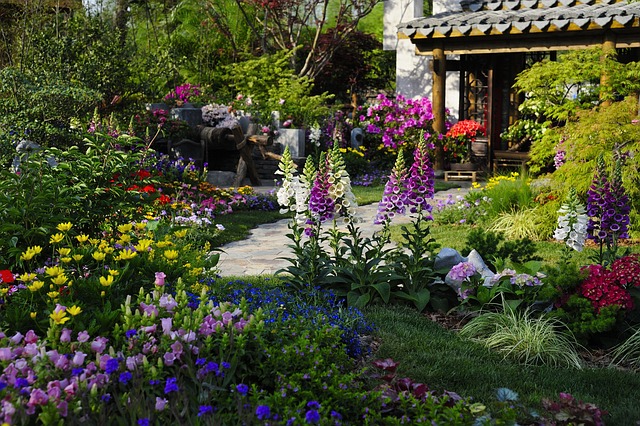Yard waste removal and recycling through composting is a sustainable method for gardeners to enrich soil quality while reducing environmental impact. By segregating compostable materials like grass clippings, leaves, and branches from non-compostable waste, and then chopping or shredding them, you accelerate the decomposition process into humus. Regular turning of the compost pile aids microbial processes by introducing oxygen, which is crucial for breaking down yard waste organically. This method not only prevents yard waste from ending up in landfills but also creates a valuable soil amendment that supports plant growth and soil fertility. Implementing this eco-friendly practice requires selecting an accessible and discreet site for your compost pile or bin, layering greens with browns to maintain the right carbon-to-nitrogen ratio, and ensuring proper aeration and moisture levels during decomposition. This approach to yard waste removal and recycling embodies sustainable land care and contributes significantly to eco-conscious waste management. It's a win-win for both gardeners and the environment.
Embark on a greener path with our comprehensive guide to transforming your yard waste into a treasure trove for your garden. Garden enthusiasts will discover efficient yard waste removal strategies that streamline the process of maintaining their outdoor spaces. Delve into the art of compost creation, leveraging trimmings and organic matter to enrich soil and foster healthy plant growth. Our article, “Compost Creation for Garden Enthusiasts,” covers everything from setting up a compost bin to recycling your yard waste into nutrient-rich compost, ensuring you make the most of your gardening endeavors sustainably. Join us as we explore practical, eco-friendly methods for yard waste removal and recycling that will keep your garden thriving all year round.
- Efficient Yard Waste Removal Strategies for Gardeners
- Mastering the Art of Compost Creation with Yard Trimmings
- Recycling Your Yard Waste into Nutrient-Rich Garden Compost
Efficient Yard Waste Removal Strategies for Gardeners

Gardening enthusiasts are increasingly turning to compost creation as a sustainable way to recycle yard waste, thereby enriching their gardens and reducing environmental impact. Efficient yard waste removal strategies play a pivotal role in this eco-friendly practice. One effective approach is to identify compostable materials that can be collected directly from the garden or yard. These typically include grass clippings, leaves, branches, and plant trimmings. By segregating these materials from non-compostable waste, gardeners can optimize the decomposition process and minimize contamination.
To enhance the composting efficiency, it’s beneficial to chop or shred larger pieces of yard waste into smaller sizes. This not only speeds up the breakdown but also ensures a more uniform composition that promotes aeration and moisture retention within the compost pile. Additionally, regular turning of the compost heap can aerate the material and introduce oxygen, which is crucial for the microbial activity that transforms yard waste into nutrient-rich humus. Implementing these strategies not only streamlines the composting process but also contributes to a healthier garden ecosystem by providing high-quality organic matter that supports soil fertility and plant growth. Yard waste removal and recycling through composting is a rewarding endeavor for gardeners who are committed to sustainable gardening practices.
Mastering the Art of Compost Creation with Yard Trimmings

Yard waste removal and recycling through composting is an eco-friendly alternative to traditional disposal methods, offering a wealth of benefits for both the environment and your garden. As a garden enthusiast, harnessing the natural decomposition process not only repurposes organic materials but also enriches the soil, promoting sustainable land care practices. To begin mastering the art of compost creation with yard trimmings, it’s crucial to select a suitable site for your compost pile or bin. This area should be conveniently accessible for adding materials and managing the composting process, yet out of the way enough to minimize odors and pests.
Once your composting area is established, you can start incorporating various yard trimmings into your compost. Green waste such as grass clippings, leaves, and garden prunings are ideal ‘greens’ that provide nitrogen and moisture. Kitchen scraps like fruit and vegetable peels or coffee grounds can also be added, offering additional nutrients. Balance these ‘greens’ with ‘browns,’ which include dry leaves, straw, and shredded paper or cardboard. These materials contribute carbon and help regulate the composting temperature and moisture levels. Regular turning of the compost pile and maintaining a balanced mix of greens and browns will facilitate the decomposition process, resulting in nutrient-rich compost that can be used to amend garden soil and enhance plant growth. Yard waste removal and recycling through composting not only diverts organic materials from landfills but also creates a sustainable resource for your gardening endeavors.
Recycling Your Yard Waste into Nutrient-Rich Garden Compost

Yard waste can be a significant component of household waste, but it holds tremendous value for garden enthusiasts looking to enrich their soil naturally. By engaging in yard waste removal and recycling, you transform what would typically be discarded into nutrient-rich compost that benefits both your plants and the environment. Composting is a practical solution for managing yard waste such as grass clippings, leaves, twigs, and garden prunings, which otherwise might contribute to landfill waste. The process of decomposing these organic materials not only reduces the need for chemical fertilizers but also supports soil biodiversity by introducing beneficial microorganisms and worms into the garden ecosystem.
To initiate composting, select a suitable spot in your yard that is convenient for adding waste regularly. Ensure the area is level to avoid runoff. Begin by gathering your yard waste into distinct categories: greens (nitrogen-rich materials like grass clippings and kitchen scraps) and browns (carbon-rich materials such as dried leaves, straw, and shredded paper). A balanced compost pile should consist of an equal ratio of these two types of materials to promote effective decomposition. Regularly mix the compost to ensure even aeration and moisture distribution, which are crucial for the decomposition process. Monitor the compost’s temperature and moisture levels, as these factors indicate the health and progress of your composting process. By adhering to these simple steps and embracing yard waste removal and recycling, you can produce a high-quality compost that will nourish your garden and contribute to sustainable waste management practices.
Garden enthusiasts looking to enrich their soil naturally can attest to the benefits of compost creation, an eco-friendly practice that transforms yard waste into valuable nutrients for plants. By implementing efficient yard waste removal strategies and mastering the art of composting with trimmings, gardeners can significantly reduce their environmental footprint while fostering a thriving garden ecosystem. Recycling yard waste not only simplifies the disposal process but also yields a nutrient-rich compost that enhances soil quality and plant growth. Embracing these practices, anyone can turn what was once considered waste into a sustainable solution for garden enrichment.






